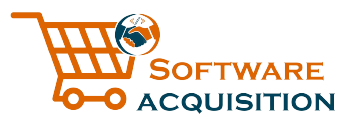In order to successfully acquire software solutions, organizations need to follow a series of steps known as the software acquisition process. This process, also referred to as the software procurement lifecycle, ensures that organizations make informed decisions and select the most suitable software solutions to meet their needs.
Key Takeaways:
- Planning and requirements gathering are crucial initial steps in the software acquisition process.
- Researching different software solutions and evaluating them effectively is essential.
- Creating a product evaluation matrix helps compare and assess different software solutions.
- Consistency in vendor evaluation ensures fair and accurate comparisons.
- Setting expenditure limits and selecting the appropriate vendor solicitation document are key steps in the path to purchase.
The software acquisition process also involves negotiating contracts, implementing the selected software solution, and monitoring and evaluating its performance. To ensure a successful software acquisition, organizations should embrace a modern software procurement process characterized by automation, collaboration, data-driven decision-making, scalability, and a proactive approach.
Planning and Requirements Gathering for Software Acquisition
The first crucial step in the software acquisition process is strategic planning and thorough requirements gathering. This stage sets the foundation for successful software procurement by ensuring that the organization’s needs and objectives are clearly defined.
During the planning phase, it is important to obtain executive support and buy-in to ensure that the software acquisition process receives the necessary resources and attention. Additionally, identifying key stakeholders who will be involved in the decision-making process is essential.
Defining the problem that the software will solve is another crucial aspect of this stage. By understanding the specific challenges and pain points that the organization is facing, it becomes easier to identify the right software solution that will address these issues effectively.
To gather requirements, it is important to consult with various departments and individuals within the organization. This includes engaging with end-users who will directly interact with the software, as well as IT resources who can provide insights into technical requirements and data security considerations.
By investing time and effort into planning and requirements gathering, organizations can ensure that they embark on the software acquisition process with a clear understanding of their needs, goals, and potential solutions. This sets the stage for successful software procurement and implementation.
Researching Software Solutions
Once the requirements are defined, organizations need to conduct thorough research to identify potential software solutions that align with their needs. This research phase is crucial in the software acquisition process as it sets the foundation for finding the best solution. To ensure a comprehensive evaluation, it is recommended to follow a structured approach.
1. Talk to Peers: Interacting with peers from similar organizations can provide valuable insights and recommendations on software solutions they have implemented. This can help narrow down the options and save time in the research process.
2. Consult IT Resources: Engaging with the IT department or specialized professionals within the organization can offer expert advice on available software solutions. Their expertise can help identify potential vendors or products that meet specific requirements and align with the organization’s overall IT strategy.
3. Consider Data Security Requirements: In today’s digital landscape, data security is of paramount importance. Therefore, it is essential to evaluate potential software solutions based on their ability to meet the organization’s data security requirements. This includes assessing the software’s encryption protocols, access control mechanisms, and compliance with relevant data protection regulations.
4. Utilize Internet Resources: The internet is a vast resource that can provide valuable information about software solutions. Online reviews, forums, and vendor websites can offer insights into product features, customer experiences, and industry trends. It is important to gather information from multiple sources to obtain a well-rounded view of each potential solution.
By conducting thorough research using these strategies, organizations can narrow down the pool of potential software solutions and identify those that best align with their requirements. This research will lay the groundwork for creating a product evaluation matrix in the next step of the software acquisition process.
Creating a Product Evaluation Matrix
To streamline the software evaluation process, organizations should create a comprehensive product evaluation matrix that allows for easy comparison of different solutions. This matrix serves as a structured framework to assess the software’s capabilities against predefined requirements.
The first step in creating a product evaluation matrix is to identify the key criteria that are important to your organization. These criteria may include functionality, ease of use, scalability, cost, support, and security. Once you have determined the criteria, assign a weight or importance to each, depending on their relative significance to your organization’s needs.
Next, create a table with rows representing the different software solutions under consideration and columns representing the criteria. Populate the cells with scores or ratings based on how well each solution meets each criterion. These scores can be numerical, such as on a scale of 1 to 5, or you can use a color-coded system to indicate the level of satisfaction.
| Software Solution | Functionality | Ease of Use | Scalability | Cost | Support | Security |
|---|---|---|---|---|---|---|
| Solution A | 4 | 3 | 5 | 4 | 3 | 5 |
| Solution B | 5 | 4 | 3 | 4 | 4 | 4 |
| Solution C | 3 | 5 | 4 | 3 | 5 | 3 |
Once you have filled in the scores for each solution, calculate an overall score by multiplying the scores by the corresponding weights and summing them up. This will give you a quantitative measure of each solution’s suitability for your organization.
The product evaluation matrix provides a visual representation of the strengths and weaknesses of each software solution, allowing you to make an informed decision. By using this matrix, organizations can save time and effort by focusing on the solutions that align best with their requirements, ultimately leading to a successful software acquisition process.
Consistency in Vendor Evaluation
Ensuring consistency throughout the vendor evaluation process is crucial to make unbiased comparisons and select the most suitable software solution. By asking the same questions to each company and involving consistent stakeholders in each software demonstration, organizations can eliminate variables that could potentially skew the evaluation results.
One way to maintain consistency is by creating a standardized evaluation form or template that can be used for each vendor. This form should include predetermined criteria and rating scales to objectively assess each solution’s suitability. Having a structured evaluation process allows organizations to compare the strengths and weaknesses of each option more effectively.
In addition to using a standardized evaluation form, organizations should also consider involving the same team members in each vendor demonstration. This ensures that all stakeholders have an equal opportunity to assess the software’s functionalities and provide valuable input. By doing so, organizations can avoid any potential biases that may arise from different team members’ viewpoints.
Table 1: Criteria for Vendor Evaluation
| Criteria | Weight |
|---|---|
| Functionality | 30% |
| Usability | 20% |
| Cost | 15% |
| Support and Maintenance | 15% |
| Integration Capabilities | 10% |
| Data Security | 10% |
By following these best practices for consistency in vendor evaluation, organizations can ensure an unbiased and thorough assessment of software solutions. This helps in selecting the most suitable option that meets all their requirements and aligns with their long-term goals.
Path to Purchase: Setting Expenditure Limits and Vendor Solicitation
Once a software solution is selected, organizations need to establish expenditure limits and decide on the type of vendor solicitation document that suits their procurement requirements. This step is crucial in ensuring that the software acquisition process remains within budget and aligns with the organization’s needs. By setting prudent expenditure limits, organizations can avoid overspending and make informed decisions regarding vendor selection.
An expenditure limit serves as a financial boundary, helping organizations stay focused on their budget constraints. It allows decision-makers to evaluate different vendor offers based on their budgetary capacity and prevents unnecessary financial strain. When setting expenditure limits, it is essential to consider factors such as the organization’s financial resources, desired software functionality, and long-term benefits.
Once the expenditure limits are defined, organizations can move forward with selecting the appropriate vendor solicitation document. The type of document chosen will depend on the specific procurement requirements of the organization. Common options include a request for information (RFI), request for quote (RFQ), or request for proposal (RFP).
Request for Information (RFI)
A Request for Information (RFI) is typically used when organizations need more information about a particular software solution or have specific questions that they want potential vendors to address. This document allows organizations to gather valuable insights about the vendor’s capabilities, technology stack, pricing structure, and implementation process. The RFI helps narrow down the list of potential vendors and facilitates better decision-making in the subsequent stages of the software acquisition process.
Request for Quote (RFQ)
A Request for Quote (RFQ) is suitable when organizations have a clear understanding of their software requirements and are seeking detailed pricing information from vendors. The RFQ provides an opportunity for organizations to compare pricing structures, negotiate costs, and identify any potential hidden fees. It allows for a more transparent evaluation of vendors’ pricing models, helping organizations make informed financial decisions.
Request for Proposal (RFP)
A Request for Proposal (RFP) is utilized when organizations require vendors to submit a comprehensive proposal that includes detailed information about their software solution, implementation plan, pricing, and support services. The RFP is particularly beneficial for complex software acquisitions that involve significant customization or integration requirements. It allows organizations to evaluate vendors based on their ability to meet specific needs and ensures transparency in the decision-making process.
By carefully considering the expenditure limits and choosing the most suitable vendor solicitation document, organizations can streamline the software acquisition process and set the stage for successful procurement. These steps are critical in ensuring that organizations make informed decisions, stay within budget, and acquire software solutions that align with their unique requirements.
Negotiating Contracts and Implementing Software
After selecting the ideal software solution, organizations must engage in contract negotiations and ensure the successful implementation of the software. Contract negotiations play a crucial role in defining the terms and conditions that govern the relationship between the organization and the software vendor. It is essential to carefully review all contractual terms, including pricing, licensing agreements, support services, and maintenance agreements.
To facilitate successful contract negotiations, organizations should establish clear objectives and requirements, ensuring that the contract aligns with their needs and expectations. This includes clarifying deliverables, timelines, and performance metrics. It is also advisable to involve legal counsel and procurement professionals who specialize in software contracts to ensure compliance and mitigate potential risks.
Once the contract is finalized, the focus shifts to the implementation phase. Successful implementation requires careful planning and coordination between the organization and the software vendor. This includes defining the implementation timeline, establishing a project team, and assigning responsibilities to ensure smooth execution. Regular communication and collaboration between all stakeholders is crucial to address any issues or challenges that may arise during the implementation process.
During the implementation phase, organizations should also consider training their staff to effectively utilize the new software. This ensures that employees are equipped with the necessary skills to maximize the software’s potential and drive operational efficiency. Additionally, organizations should establish a monitoring mechanism to track the performance and impact of the implemented software, allowing for timely intervention and continuous improvement.
| Key Steps for Negotiating Contracts and Implementing Software |
|---|
| 1. Define contract objectives and requirements |
| 2. Review and negotiate contractual terms |
| 3. Involve legal counsel and procurement professionals |
| 4. Plan and coordinate implementation activities |
| 5. Establish a project team and assign responsibilities |
| 6. Provide training for employees |
| 7. Monitor software performance and impact |
Monitoring and Evaluating Software Performance
Continuous monitoring and evaluation are essential to ensure the software solution performs optimally and fulfills organizational requirements. By implementing a robust assessment strategy, organizations can identify any issues or areas for improvement, allowing them to make data-driven decisions to enhance the software’s performance.
One effective method for monitoring software performance is to establish key performance indicators (KPIs) that align with organizational goals. These KPIs can include metrics such as user satisfaction, system uptime, response time, and error rates. Regularly tracking these indicators provides valuable insights into the software’s overall performance and allows organizations to proactively address any issues that may arise.
Additionally, implementing user feedback mechanisms, such as surveys or focus groups, can provide valuable insights into user satisfaction and identify areas where the software may fall short. By actively seeking and incorporating user feedback, organizations can continuously improve the software and ensure it remains aligned with user needs and expectations.
| Methods for Monitoring and Evaluating Software Performance | Benefits |
|---|---|
| Regular performance testing and benchmarking | – Identifies performance bottlenecks and areas for improvement – Allows for comparison against industry standards and competitors |
| Automated error tracking and logging | – Enables prompt identification and resolution of software bugs and issues – Provides a comprehensive record of system errors for future analysis |
| Real-time analytics and monitoring dashboards | – Provides instant visibility into key performance metrics – Facilitates proactive decision-making and issue resolution |
By employing a comprehensive monitoring and evaluation approach, organizations can ensure that the software solution remains aligned with their requirements and continues to deliver value over time. Regularly assessing the software’s performance, leveraging user feedback, and utilizing monitoring tools and techniques will enable organizations to make informed decisions and drive continuous improvement.
Characteristics of a Modern Software Procurement Process
A modern software procurement process embodies key characteristics such as automation, collaboration, and data-driven decision-making to optimize the acquisition of software solutions. These characteristics ensure that organizations can effectively navigate the complexities of the software acquisition journey and maximize the value of their investments. Let’s explore these characteristics in detail.
Automation
In today’s fast-paced business environment, automation plays a vital role in streamlining the software procurement process. By automating repetitive tasks such as vendor assessment, document generation, and contract management, organizations can save valuable time and resources. Automation also helps eliminate manual errors and ensures consistency throughout the procurement lifecycle.
Collaboration
Collaboration is an essential aspect of a modern software procurement process. Involving cross-functional teams and stakeholders from various departments fosters a shared understanding of requirements and enables effective decision-making. Collaborative tools and platforms facilitate real-time communication, enabling seamless collaboration among team members, vendors, and external consultants.
Data-Driven Decision-Making
Data-driven decision-making is crucial for selecting the most suitable software solution. By leveraging data analytics and insights, organizations can make informed decisions based on objective criteria. Analyzing key performance indicators, evaluating vendor capabilities, and conducting thorough assessments empower organizations to choose software solutions that align with their strategic goals and deliver optimal results.
Additionally, data-driven decision-making enables organizations to mitigate risks and improve the predictability of software procurement outcomes. By relying on quantitative and qualitative data, organizations can anticipate potential challenges, identify hidden costs, and make proactive adjustments throughout the acquisition process.
In summary, a modern software procurement process embraces automation, collaboration, and data-driven decision-making. By leveraging these characteristics, organizations can successfully navigate the software acquisition landscape and optimize their investments in software solutions.
| Characteristics | Benefits |
|---|---|
| Automation | – Saves time and resources – Eliminates manual errors – Ensures consistency |
| Collaboration | – Fosters shared understanding – Enables effective decision-making – Facilitates real-time communication |
| Data-Driven Decision-Making | – Enables informed decisions – Aligns with strategic goals – Improves predictability and risk mitigation |
Conclusion
Mastering the software acquisition process steps is crucial for organizations to navigate the complexities of software procurement and achieve successful outcomes. By following a structured approach, organizations can ensure that the software they acquire aligns with their needs and maximizes their return on investment.
Starting with the planning and requirements gathering phase, organizations need to identify stakeholders, obtain executive support, and clearly define the problem that the software will solve. This sets the foundation for the subsequent stages of the process.
Thorough research is essential to explore various software solutions and evaluate them effectively. Organizations should consult with peers, leverage IT resources, consider data security requirements, and utilize internet searches to identify potential products that meet their needs.
A product evaluation matrix helps organizations compare different software solutions based on predefined requirements. This matrix allows for consistent and objective evaluation, ensuring that the selected software aligns with the organization’s goals and objectives.
Once a software solution is chosen, organizations proceed to the path of purchase. Here, they establish expenditure limits and select the appropriate vendor solicitation document, such as a request for information, request for quote, or request for proposal.
The final stages of the software acquisition process involve negotiating contracts with the selected vendor and implementing the software solution. It is crucial to monitor and evaluate the performance of the implemented software to address any issues that may arise and ensure its effectiveness in meeting the organization’s goals.
A modern software procurement process should be automated, collaborative, data-driven, scalable, and proactive. Organizations can leverage technology to streamline the acquisition process, promote collaboration among stakeholders, make data-driven decisions, scale their software solutions as needed, and take a proactive approach to address future needs.
In conclusion, mastering the software acquisition process steps allows organizations to navigate the complexities of software procurement successfully. By following a structured approach, organizations can select the right software solution that aligns with their needs, maximize their return on investment, and drive success in their operations.
FAQ
What are the steps involved in the software acquisition process?
The software acquisition process involves several steps, including planning and requirements gathering, researching software solutions, creating a product evaluation matrix, consistency in vendor evaluation, the path to purchase, negotiating contracts and implementing software, monitoring and evaluating software performance, and following the characteristics of a modern software procurement process.
Why is planning and requirements gathering important in the software acquisition process?
Planning and requirements gathering are crucial in the software acquisition process as they help organizations obtain executive support, identify stakeholders, and define the problem that the software will solve. This ensures that the software meets organizational needs and aligns with the overall software acquisition strategy.
How should organizations research software solutions during the acquisition process?
Organizations should research software solutions by talking to peers, consulting IT resources, considering data security requirements, and using the internet to search for potential products. This helps gather information about different software options and evaluate their suitability for the organization.
What is a product evaluation matrix and why is it important in software acquisition?
A product evaluation matrix is a tool used to compare different software solutions based on predefined requirements. It helps organizations objectively assess the strengths and weaknesses of each solution and make an informed decision based on their specific needs.
Why is consistency important during the vendor evaluation process?
Consistency is important during the vendor evaluation process to ensure a fair and accurate comparison between different software vendors. By asking the same questions to each company and involving the same stakeholders in each software demonstration, organizations can compare solutions on a level playing field.
What is the path to purchase in the software acquisition process?
The path to purchase involves setting expenditure limits and deciding on the type of vendor solicitation document to use, such as a request for information, request for quote, or request for proposal. This helps streamline the procurement process and ensure that organizations receive the necessary information from vendors to make an informed decision.
What is the importance of negotiating contracts and implementing software in the acquisition process?
Negotiating contracts and implementing software are crucial stages in the software acquisition process. Negotiating contracts ensures that organizations secure favorable terms and conditions, while implementing software involves the successful installation and deployment of the selected solution to start realizing its benefits.
Why is monitoring and evaluating software performance important?
Monitoring and evaluating software performance allows organizations to assess the effectiveness of the implemented solution, identify any issues or areas for improvement, and take proactive action to address them. This ensures that the software continues to meet organizational needs and delivers the expected outcomes.
What are the characteristics of a modern software procurement process?
A modern software procurement process should be automated, collaborative, data-driven, scalable, and proactive. Automation streamlines the process, collaboration involves key stakeholders, data-driven decision-making ensures objective choices, scalability allows for future growth and flexibility, and a proactive approach helps anticipate and address potential challenges.
Why is following the software acquisition process steps important?
Following the software acquisition process steps is important for successful software procurement as it ensures that organizations consider all necessary factors, make informed decisions, and implement software solutions that meet their specific needs. It reduces the risk of making costly mistakes and maximizes the chances of achieving desired outcomes.




